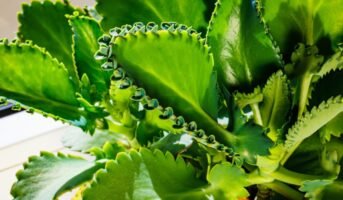Known for its long, arching leaves adorned with white stripes, the spider plant is a favourite among beginners and seasoned plant enthusiasts alike.
Don’t let the name fool you—spider plants (Chlorophytum comosum) are anything but creepy. They are incredibly easy to grow and can tolerate various light levels. Spider plant care is easy– if you forget to water them weekly, they’ll forgive you. With its ability to thrive in a variety of conditions and its air-purifying qualities, the spider plant is a fantastic choice to add a touch of nature and elegance to any indoor space.
See also: Is Cactus apt as an indoor plant?

Source: Pinterest (Balcony Garden Web)
Spider plant: Key facts
| Scientific name | Chlorophytum comosum |
| Family | Asparagaceae |
| Origin | Central and Southern Africa |
| Soil | Loamy and well-drained |
| Temperature | Below 50 degrees °F |
| Sunlight | Partial |
| Flowers | White |
| Plant type | Houseplant |
Spider plant: Physical description
Spider plants, also known as “airplane plants”, are popular houseplants with long, arching leaves that resemble spider legs. It features narrow, green leaves with a central white stripe running down the middle, giving it an attractive variegated appearance. The leaves are typically around 20-40 cm long and grow in a rosette-like arrangement.
The plant produces small, white flowers on long stalks that eventually give rise to small planets, or “spiderettes,” which dangle from the parent plant like spiders on a web. They are incredibly low-maintenance, thriving in any light condition and forgiving if you forget to water them weekly. Spider plants can be grown in containers or hanging baskets, making them a versatile addition to any home.
Spider plant: How to grow?
To grow a spider plant (Chlorophytum comosum), follow these pointers:
Light: Place the plant in bright, indirect light. Steer clear of direct sunlight because it may scorch the foliage.
Temperature: Spider plants thrive in temperatures between 60-75°F (15-24°C). Keep them away from drafts and extreme temperatures.
Watering: Water the plant thoroughly, and then wait until the top inch of soil has dried before watering again. Overwatering should be avoided since it can cause root rot.
Humidity: Spider plants prefer moderate humidity levels. Mist the leaves occasionally or place a tray of water nearby to increase humidity.
Soil: Use well-draining soil that retains some moisture. Peat moss, perlite, and potting soil mixed together work well.
Fertiliser: Feed the plant with a balanced houseplant fertiliser every 2-3 months during the growing season.
Propagation: Spider plants produce “spiderettes”, or baby plants. Once they develop roots, separate and pot them in their containers.
Repotting: Spider plants like slightly crowded roots. Repot every 1-2 years or when the roots outgrow the container.
Following these guidelines, you can enjoy a thriving spider plant that adds beauty to your indoor or outdoor space.

Source: Pinterest (Rural Sprout)
Spider plant: Care tips
- Put your spider plant in a spot with bright, indirect sunlight.
- Water your spider plant thoroughly but allow the soil to dry out between waterings.
- Spider plants prefer slightly acidic soil, so use a well-draining potting mix.
- Spider plants benefit from occasional misting to increase humidity.
- Regularly remove yellow or brown leaves to maintain plant health and appearance.
- Watch for common houseplant pests like spider mites or aphids. Treat infestations promptly with insecticidal soap.
Spider plant: Benefits
Spider plants are popular indoor plants known for their attractive appearance and numerous benefits. The followings are some key benefits of spider plants:
Air purification
Spider plants are excellent air purifiers, removing harmful toxins like formaldehyde, xylene, and carbon monoxide from the air. It promotes a healthier indoor environment.
Oxygen production
Like other plants, spider plants release oxygen during photosynthesis. It helps to improve air quality and makes them ideal for bedrooms or offices where fresh air circulation may be limited.
Easy maintenance
Spider plants are low-maintenance and forgiving. They tolerate a range of light conditions and require minimal watering. They are ideal for beginners or busy individuals who want a beautiful plant with little care.
Natural beauty
With their cascading green and white striped leaves, spider plants add an aesthetic appeal to any space. They can be grown in hanging baskets, on shelves, or as trailing plants.
Stress reduction
Spider plants can reduce stress levels and enhance mood.
Spider plant: Toxicity
Spider plants are generally considered non-toxic to humans and pets. It makes spider plants a popular choice for indoor gardening, as they can be enjoyed without the worry of accidental ingestion causing harm. However, while spider plants are generally safe, watching curious pets and children is crucial to preventing plant-related accidents.
FAQs
How often should I water my Spider plant?
When the soil in the top inch is dry, water your spider plant. Be careful not to overwater, as this can lead to root rot. Spider plants are relatively tolerant of underwatering and can recover from slight droughts.
Can Spider plants tolerate low light conditions?
Spider plants can tolerate low light conditions but prefer bright, indirect light. They may not thrive or produce as many spiderettes (baby spider plants) in low light, but they can still survive.
How do I propagate spider plants?
Spider plants can be easily propagated by planting the spiderettes, the small plantlets that grow on long stems. These can be planted in moist soil or placed in water until they develop roots. Another method is by dividing the plant’s root ball during repotting.
How fast do spider plants grow?
Spider plants are known for their rapid growth. Under ideal conditions, they can produce multiple long, arching leaves and spiderettes, increasing the size of the plant in a relatively short time.
Can spider plants be grown outdoors?
Spider plants are primarily grown as indoor plants. However, they can be grown outdoors in warm climates as long as they are protected from direct sunlight, which can scorch their leaves.
| Got any questions or point of view on our article? We would love to hear from you. Write to our Editor-in-Chief Jhumur Ghosh at [email protected] |
Housing News Desk is the news desk of leading online real estate portal, Housing.com. Housing News Desk focuses on a variety of topics such as real estate laws, taxes, current news, property trends, home loans, rentals, décor, green homes, home improvement, etc. The main objective of the news desk, is to cover the real estate sector from the perspective of providing information that is useful to the end-user.
Facebook: https://www.facebook.com/housing.com/
Twitter: https://twitter.com/Housing
Email: [email protected]











